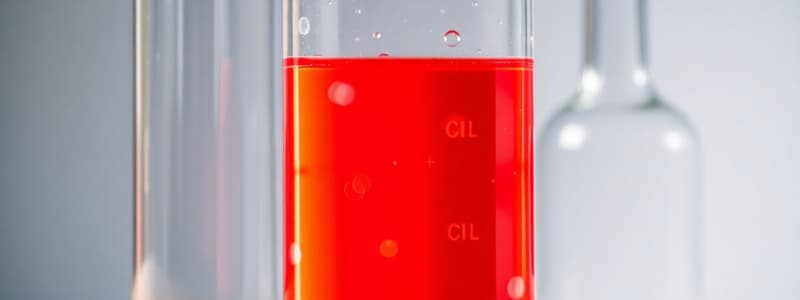Podcast
Questions and Answers
Which of the following observations would indicate that magnesium is reacting with hydrochloric acid?
Which of the following observations would indicate that magnesium is reacting with hydrochloric acid?
- A black solid forms.
- The solution becomes a deeper blue.
- The reaction mixture cools down.
- Effervescence is observed. (correct)
The reactivity of Group 1 metals decreases as you move down the group.
The reactivity of Group 1 metals decreases as you move down the group.
False (B)
Write a balanced chemical equation for the reaction between lithium and water.
Write a balanced chemical equation for the reaction between lithium and water.
Lithium + Water → Lithium Hydroxide + Hydrogen
A metal will only react with an acid if it is more reactive than _________.
A metal will only react with an acid if it is more reactive than _________.
Match each metal with the correct observation when reacted with acid :
Match each metal with the correct observation when reacted with acid :
In the extraction of iron from its ore, which substance acts as the reducing agent?
In the extraction of iron from its ore, which substance acts as the reducing agent?
Which of the following statements correctly defines oxidation in terms of electron transfer?
Which of the following statements correctly defines oxidation in terms of electron transfer?
Based on the provided reactivity series, can zinc displace magnesium from a magnesium sulphate solution?
Based on the provided reactivity series, can zinc displace magnesium from a magnesium sulphate solution?
Flashcards
Magnesium + Oxygen reaction
Magnesium + Oxygen reaction
Reaction where Magnesium (Mg) combines with oxygen (O₂) to produce Magnesium Oxide (MgO), a white solid.
Magnesium + Hydrochloric Acid reaction
Magnesium + Hydrochloric Acid reaction
Reaction where Magnesium (Mg) reacts with Hydrochloric Acid (HCl) to produce Magnesium Chloride (MgCl₂) and Hydrogen gas (H₂).
Group 1 Reactivity Trend
Group 1 Reactivity Trend
In Group 1 (Alkali Metals), reactivity increases as you move down the group. Potassium (K) is more reactive than Lithium (Li).
Metal + Acid Reaction Rule
Metal + Acid Reaction Rule
Signup and view all the flashcards
Displacement Reaction Definition
Displacement Reaction Definition
Signup and view all the flashcards
Oxidation (in terms of electrons)
Oxidation (in terms of electrons)
Signup and view all the flashcards
Reduction (in terms of electrons)
Reduction (in terms of electrons)
Signup and view all the flashcards
Ore Definition
Ore Definition
Signup and view all the flashcards
Study Notes
- Magnesium reacts with oxygen to produce magnesium oxide, which appears as a white solid
- Magnesium reacts with hydrochloric acid to produce magnesium chloride and hydrogen
- This reaction results in effervescence, heat, and the dissolving of magnesium
- Copper sulphate reacts with magnesium to produce magnesium sulphate and copper
- This reaction results in a black solid forming and the solution turns paler blue
Group 1: Alkali Metals
- Group 1 metals are the most reactive metals
- Reactivity increases down the group, from Lithium (Li) to Potassium (K)
- Alkali metals react similarly with water, producing effervescence and dissolving and begin to move around in the solution
- Sodium melts during its reaction and Potassium self-ignites with a lilac-colored flame
- Lithium reacts with water to produce Lithium Hydroxide and Hydrogen
Reactions With Acids
- Four metals (Ca, Cu, Mg, Zn) were reacted with a strong acid
- Calcium: violent fizzing, heats up, white solid forms
- Copper: No visible reaction
- Magnesium: effervescence, heats up, dissolves
- Zinc: Slight bubbles on surface
- Metals will only react with an acid if it is more reactive than hydrogen
Reactivity
- To determine the relative reactivity of elements, displacement reactions are carried out
- The more reactive metal will displace a less reactive one
Displacement Reactions
- Cu does not react with FeSO4, MgSO4, and ZnSO4
- Fe reacts with CuSO4 and displaces Mg and Zn
- Mg reacts with CuSO4, FeSO4 can displace Zn
- Zn reacts with CuSO4 and FeSO4
Oxidation and Reduction
- Oxidation and reduction are defined in terms of electrons
- Oxidation is the loss of electrons
- Reduction is the gaining of electrons
- In the example 2Fe2O3 + 3C → 4Fe + 3CO2, Iron is reduced because it gains 3 electrons
Extracting Metals
- Many metals exist in the earth's crust as ores
- An ore is a rock that contains enough compound worth extracting
- Very few metals are found in their native state, which means pure metal not bonded to anything
- Gold and platinum are examples of metals found in their native state because they are very unreactive
- How metals are extracted from their ores depends on their reactivity
- Metals less reactive than carbon are extracted by displacement using carbon
- The reaction Iron oxide → Iron + Carbon dioxide is known as reduction (removing O2)
- Elements more reactive than carbon are extracted using electrolysis
Studying That Suits You
Use AI to generate personalized quizzes and flashcards to suit your learning preferences.
Related Documents
Description
Magnesium reacts with oxygen, hydrochloric acid, and copper sulphate, each producing distinct results. Group 1 alkali metals increase in reactivity down the group, reacting vigorously with water. Calcium, Copper, Magnesium and Zinc react differently with strong acids.




